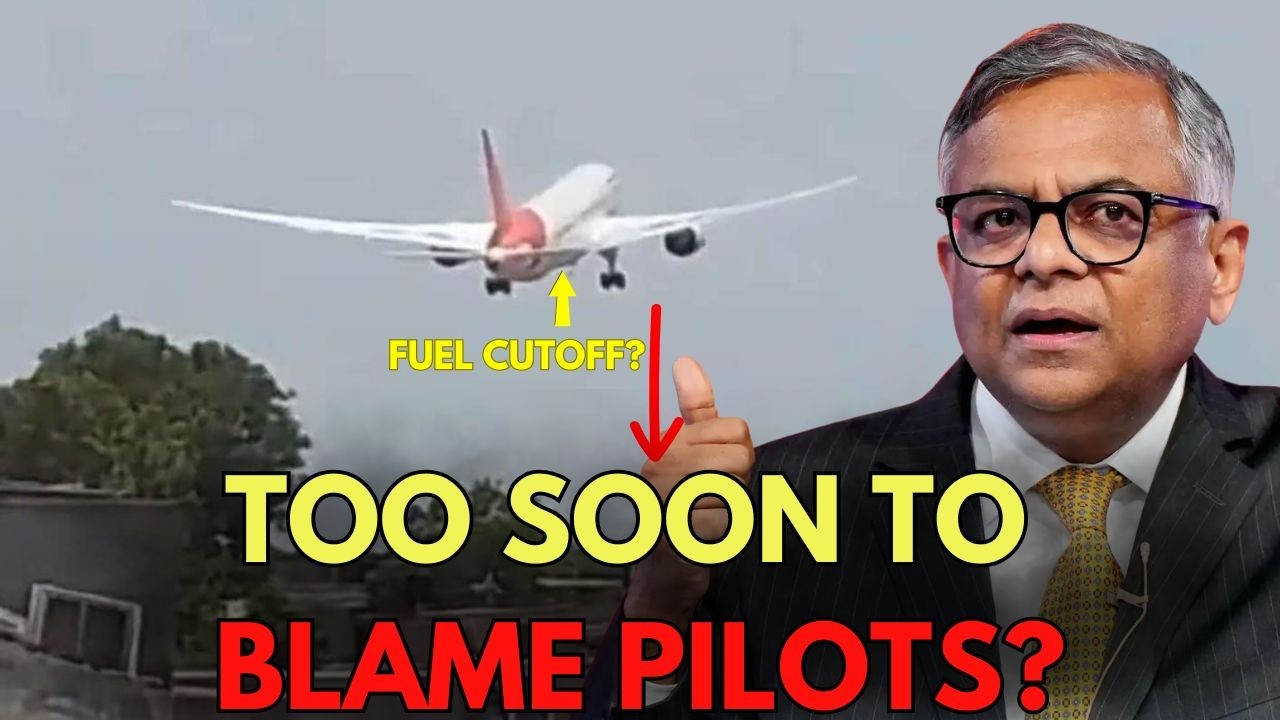Was it really the pilots’ fault? 😱 U.S. investigators drop a bombshell on the Air India 171 crash: the rush to blame the crew might be hiding a darker truth. What caused those engines to fail in just 32 seconds?
👉 Find out what they’re not telling you:

Air India Flight 171 Crash: U.S. Investigator Challenges Premature Pilot Error Theory
Introduction
On June 12, 2025, Air India Flight 171, a Boeing 787-8 Dreamliner, crashed 32 seconds after takeoff from Ahmedabad’s Sardar Vallabhbhai Patel International Airport, en route to London Gatwick. The disaster, which killed 241 of the 242 people on board and 19 on the ground, marked the first fatal crash of a Boeing 787 since its 2011 debut and the deadliest aviation accident in India since 1996. The preliminary report by India’s Aircraft Accident Investigation Bureau (AAIB), released on July 8, 2025, revealed that both engines lost thrust when their fuel control switches moved from “RUN” to “CUTOFF” seconds after liftoff, with the Cockpit Voice Recorder (CVR) capturing one pilot asking, “Why did you cut off?” and the other replying, “I didn’t.” Early media reports, particularly from The Wall Street Journal, pointed to pilot error, suggesting Captain Sumeet Sabharwal may have flipped the switches. However, U.S. investigators, including the National Transportation Safety Board (NTSB), have called this theory “premature and speculative,” urging a broader examination of potential causes. This article explores the crash, the debate over pilot error, the U.S. investigator’s perspective, and the unresolved questions surrounding this tragedy.
The Crash: A Catastrophic 32 Seconds
Flight 171, carrying 230 passengers and 12 crew members, took off at 1:38:39 p.m. IST (08:08:39 UTC) with Captain Sumeet Sabharwal (15,638 flight hours, 8,596 on the 787) monitoring and First Officer Clive Kunder (3,403 hours, 1,128 on the 787) flying. The aircraft, registered VT-ANB, reached 625 feet and 180 knots before disaster struck. At 08:08:42, both fuel control switches moved to “CUTOFF” within one second, starving the General Electric GEnx-1B engines of fuel. The ram air turbine (RAT) deployed at 08:08:47, indicating a total power loss, and the landing gear remained down. The pilots returned the switches to “RUN” by 08:08:52, triggering an automatic engine relight, but only one engine began regaining thrust. At 08:09:05, a “Mayday, Mayday, Mayday” call was transmitted, reportedly including “…no power…no thrust…,” but air traffic control received no response. At 08:09:11, the plane crashed into the B.J. Medical College hostel, 1.5 kilometers from the runway, killing 260 people.
The black boxes—two Enhanced Airborne Flight Recorders (EAFRs)—were recovered on June 13 and 16, despite fire damage. Data extracted by June 26 confirmed the switch movement and captured the CVR’s haunting exchange, but the lack of speaker identification has fueled speculation. The sole survivor, Vishwaskumar Ramesh, escaped via an emergency exit, and his account of a loud “boom” aligns with a ground witness’s report, though the AAIB attributes the engine failure to the switch movement.
The Pilot Error Theory: Premature or Plausible?
The AAIB’s preliminary report, supported by FDR and CVR data, noted the fuel switches’ movement as the primary cause, prompting media outlets like The Wall Street Journal to suggest Captain Sabharwal, the monitoring pilot, may have acted deliberately or accidentally. The switches, located on the center console, require deliberate lifting and toggling, with a metal stop-lock mechanism to prevent accidental movement. Shawn Pruchnicki, a former investigator, emphasized that such an error is unlikely without evident cockpit confusion, as no prior alarms or distress were recorded.
However, U.S. investigators, including NTSB Chairwoman Jennifer Homendy, have called this focus on pilot error “premature and speculative.” In a statement on X, Homendy stressed that “investigations of this magnitude take time,” urging restraint until the final report. The Indian Commercial Pilots’ Association (ICPA) and Airline Pilots’ Association of India (ALPA) echoed this, condemning the “reckless and unfounded insinuation of pilot suicide” and demanding a transparent, data-driven probe. Both pilots passed breathalyzer tests and were rested, ruling out fatigue or intoxication. Their extensive experience—over 19,000 combined flight hours—further undermines the notion of a simple mistake.
Alternative Theories: Mechanical, Systemic, or External?
The U.S. investigator’s caution points to other potential causes:
1. Mechanical or Electronic Failure
A 2018 FAA Special Airworthiness Information Bulletin (SAIB) warned of disengaged locking mechanisms on Boeing 737 fuel switches, a design shared with the 787. Air India did not inspect VT-ANB’s switches, as the SAIB was advisory. A 2019 All Nippon Airways 787 incident, where software misjudged the plane’s state and shut down an engine, suggests a possible Full Authority Digital Engine Control (FADEC) glitch. Mary Schiavo, a U.S. aviation analyst, warned that a similar malfunction cannot be ruled out, emphasizing the need for the full CVR transcript. However, the CVR’s dialogue and the physical “click” of the switches suggest manual movement, and the FDR found no mechanical faults.
2. Maintenance Oversights
X posts and expert commentary have questioned Air India’s maintenance practices. @TimesNow reported the FAA ruling out mechanical issues, but Dan Bubb, an airline historian, noted that investigators would scrutinize Air India’s records. The 787’s throttle control module was replaced in 2019 and 2023, but these were unrelated to the fuel switches, and no defects were reported since 2023. The absence of mandatory inspections post-2018 SAIB raises concerns about oversight.
3. External Factors
Early theories of bird strikes, fuel contamination, or flap misconfiguration were dismissed. CCTV footage showed no significant bird activity, fuel samples were satisfactory, and the 787’s warning system would have flagged flap issues. The New York Times analysis confirmed the slats and flaps were extended, indicating standard takeoff procedures. The “boom” reported by the survivor could suggest an engine issue, but the FDR attributes the failure to the switch movement.
4. Sabotage or Intentional Act
Speculation about deliberate action, fueled by X posts like @eugyppius1, has been largely dismissed due to the pilots’ clean records and no evidence of threats. Anti-terror experts are involved, but the CVR’s lack of distress prior to the switch movement reduces this likelihood.
The Investigation: Challenges and Criticisms
The AAIB, with Boeing, GE Aerospace, NTSB, and UK support, is analyzing switch wreckage and conducting simulations. Air India pilots recreated the crash in a 787 simulator but could not replicate a dual-engine flame-out due to electrical failures, focusing attention on the switches. The lack of cockpit video, as noted by Peter Goelz, former NTSB managing director, hinders clarity, with calls for mandatory cameras growing louder. The AAIB’s selective disclosure of CVR excerpts, without a full transcript or speaker identification, has drawn criticism from experts like Bjorn Fehrm, who called it “totally unacceptable.” Families and the Federation of Indian Pilots (FIP) demand transparency, citing distress caused by media speculation.
The U.S. investigator’s stance, supported by Homendy’s comments, emphasizes an open-minded approach. The FAA has not issued advisories for the 787 or GEnx-1B engines, and the DGCA’s inspections of Air India’s 33 Dreamliners found no issues. The final report, expected by mid-2026, will include time-stamped CVR dialogue and detailed FDR analysis.
Implications for Aviation Safety
The crash raises questions about the 787’s fuel switch design and maintenance protocols. If a mechanical or software issue is confirmed, it could prompt global fleet inspections, impacting Boeing’s reputation, already strained by past 737 MAX issues. The low-altitude failure highlights the need for enhanced training for emergencies below 1,000 feet, where recovery is nearly impossible. The tragedy also underscores the importance of cockpit video and transparent reporting to avoid speculative narratives that harm families and the industry.
Conclusion
The Air India Flight 171 crash remains a perplexing tragedy, with the U.S. investigator’s warning against premature pilot error theories highlighting the complexity of the case. The CVR’s cryptic exchange and the FDR’s confirmation of switch movement point to human or systemic factors, but the absence of a full transcript and clear evidence leaves the cause uncertain. Mechanical flaws, maintenance oversights, or unforeseen issues cannot be ruled out, as the U.S. perspective suggests. As the AAIB continues its rigorous probe, the aviation community and grieving families await answers. The crash serves as a stark reminder that aviation safety demands patience, transparency, and a commitment to uncovering the truth, not just for the 260 lives lost but for the future of flight.





